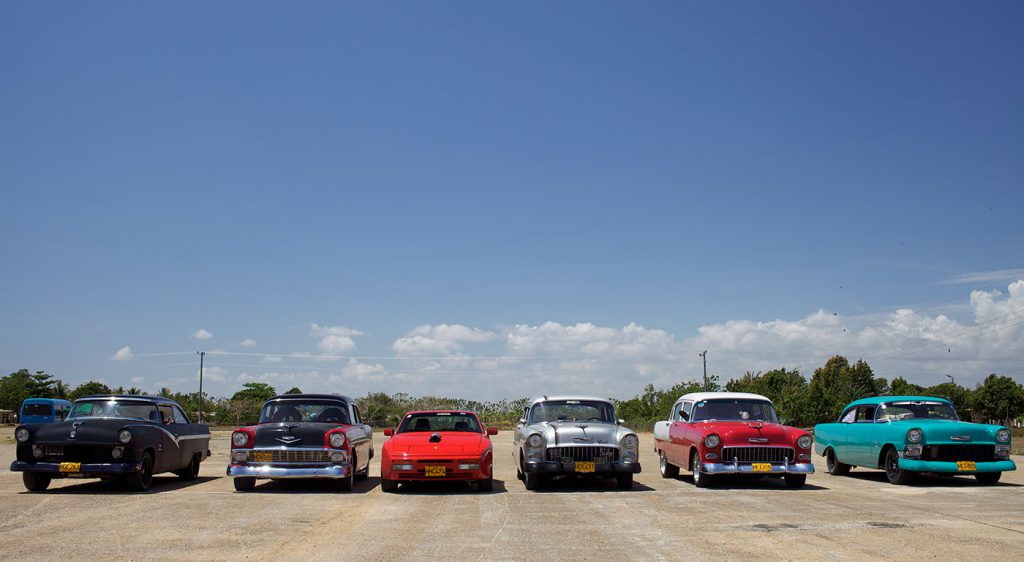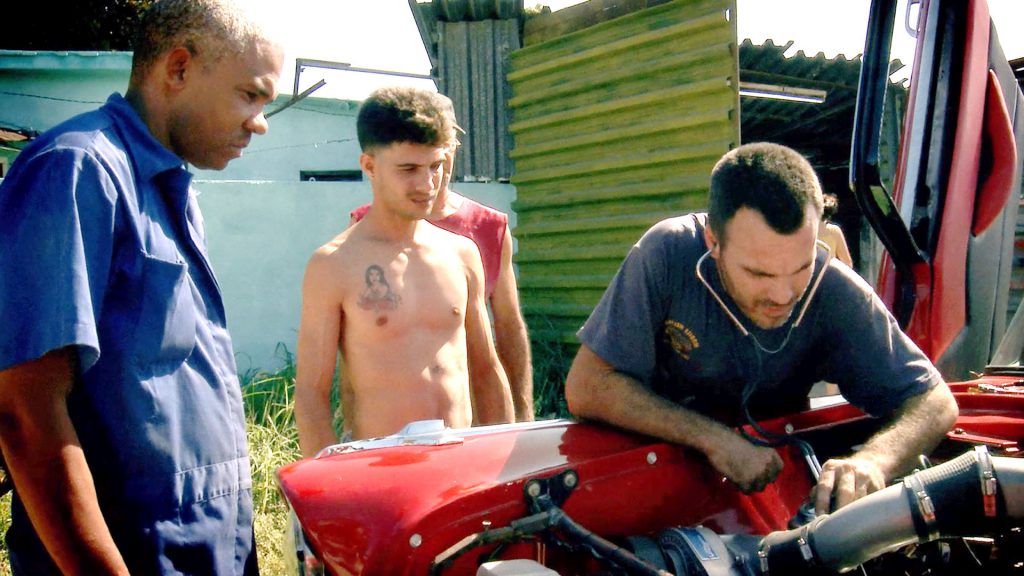¡Consigue esta oferta! Llama ahora.
Hable con un especialista en planes de protección de vehículos y obtenga $300 apagado cualquier nuevo contrato al instante.
Llamar 866-678-4172
o escanea el código a continuación


Cuba ha sido la última distorsión del tiempo para todos los entusiastas de los coches clásicos fuera de sus fronteras. El país es conocido por muchas cosas y entre ellas están las carreteras llenas de automóviles de mediados de siglo, perfectamente conservados, anteriores al embargo impuesto a la nación en 1962. Estos coches únicos y la relación que tienen con ellos sus propietarios son una gran parte de la experiencia cubana. Desde el embargo, las piezas han llegado a sus costas de forma intermitente e inconsistente, por lo que, a menudo, cuando algo es realmente necesario, la única solución es construirlo o modificarlo. Los cubanos no tienen la El lujo de las impresoras 3D Ni máquinas CNC ni dinamómetros para encontrar la potencia. Y a veces los conductores están tan orgullosos de su oficio que muestran su trabajo en carreras ilegales en línea recta en calles civiles. Esa escena y cultura es el tema del documental financiado por Kickstarter. Club del Motor de La Habana.

Dejemos esto en claro: si te encantan los autos, TIENES que ver este documental. Retrata una visión única de la cultura automotriz que es a la vez extraña y familiar para cualquier amante de los autos. La película sigue a varios conductores con su propia visión de sus máquinas. Uno de esos conductores es Carlos, que conduce un Porsche 944 (llamándolo "El Por-CHA"). Técnicamente, el auto aún pertenece a su amigo Saúl, un ciudadano de Miami con doble nacionalidad que trae piezas de Estados Unidos. Con la disponibilidad de piezas tan limitada en el condado, se puede imaginar la gran ventaja que esto supone. Sin embargo, aquí está lo mejor: el auto está registrado como Mitsubishi y el motor es un Chevrolet V-8, lo que lo convierte en un bólido cubano. Otro conductor, Rey, de familia de mecánicos, conduce un Chevrolet de 1955 que también es una combinación de piezas encontradas. Piti conduce un Ford de 1956 al que llama Bucéfalo, en honor al caballo de Alejandro Magno. Finalmente, seguimos a Jote, quien equipó su Ford de 1951, el "Black Widow", con un motor de barco, recuperado del fondo del océano para intentar contrabandear cubanos a Miami.

En la película nos enteramos de que durante un tiempo las carreras de autos han sido parte de Cuba, pero un accidente notorio durante el Gran Premio de 1958 en el que murieron siete personas dañó la reputación del deporte en la nación a partir de entonces. Después de la Revolución Cubana un año después, el gobierno de Castro declaró que las carreras de autos eran elitistas y capitalistas. El secuestro del piloto estrella Juan Manuel Fangio por parte de las fuerzas de Fidel tampoco ayudó (los corredores de la película están organizando un evento en su honor). Durante las siguientes décadas vemos en la película que Deportes de motor Se han reducido a un subcultura clandestina ilegal, con conductores que arriesgan sus autos y enfrentan sanciones penales solo por disfrutar de los placeres de conducir a toda velocidad en línea recta en carreteras públicas con sus vehículos. No derrapan ni dan vueltas, solo se disparan desde parado hasta la línea de meta, una estrategia que recuerda a la era de los autos deportivos estadounidenses. Y durante ese breve tiempo y distancia, la emoción que los conductores que seguimos dicen sentir es demasiado familiar para los corredores estadounidenses o los conductores de todo el mundo. Club del Motor de La Habana En definitiva, es la historia de cómo los aspirantes a corredores luchan por devolverle legitimidad a su amado deporte. Algo con lo que creo que todos los aficionados a las carreras de todo el mundo pueden identificarse.

A lo largo de la película obtenemos una mirada al interior de la garajes improvisados, conductores y mecánica El director Bent-Jorgen Perlmutt filma de forma muy personal y cercana, sin escatimar en detalles sobre lo que sucede con estos autos, los conductores y los lugares que habitan. Toda la película trata sobre la preparación para un intento de tener la primera carrera oficial en décadas, y el cineasta evita la historia y los detalles que los entusiastas de los autos pueden esperar a favor de una exhibición de las "actitudes" de los corredores. En otras palabras, en la segunda mitad de la película se convierte en un documental de "cabezas parlantes" donde vemos a los conductores hablando sobre carreras en tiempo pasado en lugar de ver las carreras reales. Un breve capítulo muestra al jefe de la organización automovilística clandestina tratando de "legitimarse", pero finalmente encuentra formas de posponer la carrera oficial. Esta fue, en última instancia, la parte más frustrante de la película. Sin embargo, juega con el tema de la película sobre la desesperación que acompaña a esta pasión cuando los recursos para seguirla son escasos, pero aun así hubiera sido mucho más satisfactorio explorar la cultura de las carreras real a través de imágenes de los eventos y similares en lugar de recurrir a entrevistas con presentadores.

Todo llega a su punto crítico cuando nos acercamos al presente, mucho después de que se haya levantado el embargo a Cuba y Peugeot llegue a Cuba para mostrar algunos nuevos y costosos automóviles. La decepción que siente Rey se resume cuando nos dice que “todos los automóviles modernos se ven iguales”. Y, en última instancia, esa es parte de la razón por la que el documental de Perlmutt es una visita obligada para los entusiastas de los automóviles. Cuba es un lugar muy especial para los automóviles y lo que hace que estas reliquias de los años 50 y 60 sean más que simples piezas de museo o simples recordatorios de la tumultuosa historia política de Cuba. La dirección de Perlmutt realmente brinda a los espectadores un vistazo a una sensibilidad estética específica no solo en los automóviles que nos muestra, sino en este estilo documental que realmente nos transporta a un mundo que no tiene lugar para los hatchbacks intercambiables y los hipercoches diseñados por computadora. ¿Hizo este documental porque esta subcultura está en peligro de desaparecer a medida que Cuba abre sus puertas? Compruébelo usted mismo.

Estamos aquí para asegurarnos de que obtenga la protección EV más completa. Por eso nos hemos asociado con Xcelerate automático para ofrecerle una cobertura Tesla transparente y confiable.
¿Quiere que nos comuniquemos con usted acerca de la cobertura XCare para su Tesla?



¡Llama y obtén un descuento de $300 en cualquier plan nuevo!
Al hacer clic en el botón, acepta que Endurance utilice tecnología automatizada para llamarlo, enviarle un correo electrónico y enviarle mensajes de texto utilizando la información de contacto anterior, incluido su número de teléfono móvil, si se proporciona, con respecto a la protección del automóvil o, en California, el seguro contra averías mecánicas. También acepta el Endurance política de privacidad y Términos y condiciones. El consentimiento no es una condición de compra y puede retirar el consentimiento en cualquier momento. Se pueden aplicar tarifas por mensajes y datos.
Hable con un especialista en planes de protección de vehículos y obtenga $300 apagado cualquier nuevo contrato al instante.
Llamar 866-678-4172
o escanea el código a continuación



Simplemente complete la información a continuación y le daremos seguimiento rápidamente con su cotización gratuita y sin compromiso.
Al hacer clic en el botón, acepta que Endurance utilice tecnología automatizada para llamarlo, enviarle un correo electrónico y enviarle mensajes de texto utilizando la información de contacto anterior, incluido su número de teléfono móvil, si se proporciona, con respecto a la protección del automóvil o, en California, el seguro contra averías mecánicas. También acepta el Endurance política de privacidad y Términos y condiciones. El consentimiento no es una condición de compra y puede retirar el consentimiento en cualquier momento. Se pueden aplicar tarifas por mensajes y datos.

Para hablar con un especialista en planes de protección de vehículos y guardar $300
Escanee el código a continuación
Alex ha trabajado en la industria de servicios automotrices durante más de 20 años. Luego de graduarse de una de las mejores escuelas técnicas del país, se desempeñó como técnico logrando la certificación de Maestro Técnico. También tiene experiencia como asesor de servicios y gerente de servicios. Leer más sobre alex